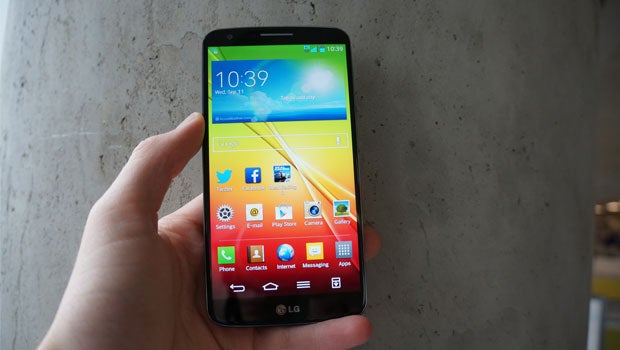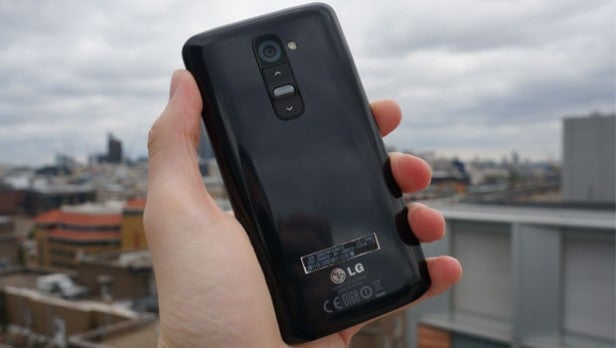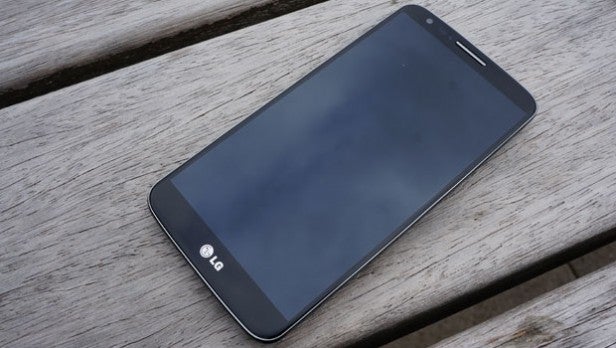LG G2 Review
LG G2
Released Today: LG is back in the smartphone game and the G2 sees it land with a bang.

Sections
- Page 1 LG G2 Review
- Page 2 Software, Performance and Camera Review
- Page 3 Call Quality, Battery, Value and Verdict Review
Verdict
Pros
- Stunning 5.2-inch edge-to-edge display
- Speedy Snapdragon 800 CPU
- Strong battery life
Cons
- Cheap plastic build
- Awkward button placement
Key Specifications
- Review Price: £400.00
- 5.2-inch Full HD IPS display
- 13-megapixel OIS camera
- Rear button placement
What is the LG G2?
The LG G2 is LG’s Android rival to the Samsung Galaxy S4 and HTC One. A phone tasked with reinstating LG as a leading player on the smartphone scene, the phone features an array of high-end innards. It has a 13-megapixel camera, a 2.26GHz quad-core CPU and an impressively large 3,000mAh battery.
Continuing the trend of ever-growing screen sizes, the LG G2 pairs a 5.2-inch Full HD display with a dramatically reduced bezel. This combination maximises the amount of on-screen real estate while keeping the phone’s overall footprint small. The phone is available in both black and white, and the LG G2 will set you back around £400 SIM-free.
Has the LG G2 done enough to truly bring the fight to the iPhone 5S and Galaxy S4? Read on to find out.

LG G2 – Design
Aesthetically the LG G2 is a pretty hit and miss affair. It features an easy on the eye design, although the overall appeal of the phone is let down by plastic build and the baffling decision to place all physical controls on its rear. While it might look like a standard candy bar at first glance, the rear controls really separate it from the Android masses, for better or for worse.
The LG G2’s design has been built around keeping the phone as small as possible, while incorporating an expansive display. The reduced bezel, down to just 2.65mm – half that of its leading rivals – helps accentuate the phone’s already oversized 5.2-inch screen. To gain these edge-to-edge benefits, however, LG has had to move the G2’s on-body buttons.
The LG G2 relocates all physical controls to the phone’s rear, with the volume rocker and power/lock buttons now sat directly beneath the camera lens. It’s awkward and confusing at first, and the LG G2 button placement failed to click with us after more than a week’s use. Although it does not feel obtrusive or at risk of accidental presses when holding the phone, it remains fiddly and unnatural.
Ultimately, reaching to the rear of the phone to lock the screen feels far more awkward than simply tapping a top or side-mounted control. The unusual button placement is not all doom and gloom, however. When changing in-call volume, the rear mounted volume rocker is a joy. Realistically though, this will be an infrequent silver lining. And button contouring does little to improve ease of use.
Like the Samsung Galaxy S4, the LG G2 is let down by a plastic body that feels flimsy in parts. As well not fitting well with the premium price tag, the plastic body features a very noticeable weak spot. Located on the right-hand side of the LG G2’s rear, there is a small area than bends and creeks when subjected to light pressure. What’s more, the gloss finish on the plastic body is a magnet for fingerprints and grime, further causing the G2 to look considerably cheaper than its lofty price would suggest.
The rear-mounted buttons don’t really add any unwanted bulk to the phone but, at 8.9mm thick, the G2 is far from the most svelte flagship offering. It’s a full millimetre thicker than either the iPhone 5S or Galaxy S4, and the LG G2 is also more than 30g weightier than Apple’s latest phone. Despite this, the G2 never feels bulky or uncomfortable in the hand, with a slight curvature to the phone’s rear giving it an ergonomic fit.

LG G2 – Screen Quality
Having lost points on design, the LG G2’s screen is something of a show stealer, wowing us from the off. The 5.2-inch Full HD IPS display features stunningly sharp 423 pixels per inch density.
The streamlined bezel of the G2 further enhances the impressive IPS panel, giving the display added pop and helping to set the handset out from the crowd. Although the phone’s footprint is no bigger than that of the S4, the G2 has a screen 0.2 inches bigger, and this makes a noticeable difference.
The reduced bezel and HD screen turn the LG G2 into a one of a kind device, but we expect to see a number of rival manufacturers follow suit in the near future.
The benefits of the LG G2’s screen are not all about the slimline bezel though. The IPS panel might not be as bright as some AMOLED display hosting rivals, but the colours are truer and less over-exaggerated. The LG G2 screen produces colours that are accurate and do not suffer from the familiar oversaturation issues of some rivals. The screen’s touch panel is responsive, with no undue lag or hesitation meeting any of the gesture commands we threw at it.
A complete package, the 423ppi image density means even the finest of details are pin-sharp and text never appears smudged or soft at the edges. The screen is capable of tackling pages of text and vibrant, detailed HD images with equal aplomb and continues to impress long after it has first grabbed your attention.
Unfortunately, the LG G2 screen quality is not without the odd blemish. The display is a little on the reflective side, with outdoor conditions producing an unwanted amount of glare. Only a slight issue, this problem is far from the same performance depleting leagues of the Huawei Ascend G510.
The LG G2’s screen quality is so good that we can almost forgive the necessary button placement move fitting in such a large, edge-to-edge display has necessitiated. Almost.
How we test phones
We test every mobile phone we review thoroughly. We use industry standard tests to compare features properly and we use the phone as our main device over the review period. We’ll always tell you what we find and we never, ever, accept money to review a product.

